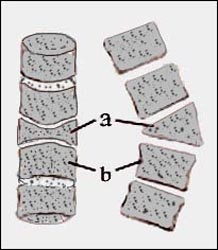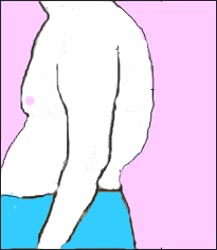척주후만증 (척주 뒤굽음증), Kyphosis
- 척주가 20~49도 정도 후만 되어 있는 것은 정상이다.
- 그보다 더 많이 후만 되어 있을 때를 척주 후만이라고 한다.
- 그로 인해 생긴 증상을 척주 후만증(脊柱後彎症)이라고 한다.
- 즉 반듯이 서 있을 때 척주가 활같이 앞으로 20~49도 이상 구부러져 있는 상태를 척주 후만이라 한다.

그림 134. 쐐기형 척추로 생긴 쉬우어만 병이 있을 때 척추 후만증이 생길 수 있다.
Copyright ⓒ 2011 John Sangwon Lee, M.D., FAAP

그림 133. 쉬우어만 병으로 생긴 척추 후만증
Copyright ⓒ 2011 John Sangwon Lee, M.D., FAAP
척주 후만증(척주 뒤굽이증)의 원인
- 태어날 때부터 척주(脊柱)에 있는 여러 개의 척추들 중 한 개 또는 여러 개가 선천성으로 없을 때 척주 후만증이 생길 수 있다.
- 정상 척주를 가지고 태어난 후 사고나 결핵성 척추염 등 어떤 질병으로 한두 개의 척추가 후천성으로 손상되면 척주 후만증이 생길 수 있다.
- 척주에 아무 이상이 없지만 등을 앞으로 많이 굽히는 습관이 있을 때, 키가 상당히 큰 아이가 부끄러워서 등을 앞으로 움츠리고 구부리고 다니는 습관, 유난히 큰 유방을 가진 사춘기 여아가 부끄러워서 앞가슴을 움츠리는 습관 등으로 활처럼 앞으로 구부러질 수 있고 척주 후만증이 생길 수 있다.
- 아주 드물게는 쉬우어만 병(Scheuermann’s disease)으로도 척주 후만이 생길 수 있다.
척주 후만증(척주 뒤굽이증)의 증상 징후
- 척주 후만증이 있는 어떤 아이에게 척주 측만증이 동시 있을 수 있다.
- 그렇지만 대부분의 경우 척주 후만증만 생겨있다.
- 척추 하나, 또는 여러 개의 척추가 선천성으로 없이 태어 났기 때문에 선천성 척주 후만증이 있을 때는 척추가 없는 척주 부위 이하 신체 계통에 신경마비도 같이 생길 수 있다.
- 척주 후만증의 원인에 따라 증상 징후가 다르다.
- 척주 통증이 있고 외관상 문제로 정신적 고통이 있을 수 있다.
척주 후만증(척주 뒤굽이증)의 진단
- 병력·증상 징후와 진찰소견 등을 종합하여 척주 후만증을 진단한다.
- 원인에 따라 척주 X선 사진 검사·척주 CT 스캔 사진 검사·척주 MRI 검사 등으로 진단할 수 있다.
척주 후만증(척주 뒤굽이증)의 치료
- 습관성으로 생긴 척주 후만증의 대부분은 올 바른 자세를 취하고 물리 치료로 치료한다.
- 그밖에 대부분의 선천성 척주 후만증은 그 원인에 따라 수술 치료하거나 또는 밀와키(Milwaukee) 브레이스로 치료한다.
Kyphosis (Kyphosis)
• It is normal for the spinal column to be only 20-49 degrees posterior. • When there is more kyphosis than that, it is called kyphosis.
• The resulting symptoms are called spinal kyphosis.
• In other words, the state in which the spine is bent forward 20~49 degrees or more like a bow when standing upright is called kyphosis.

Fig. 134. Scheuermann’s disease of the wedge-shaped spine can cause kyphosis. a – wedge-shaped vertebrae, b – normal vertebrae Copyright ⓒ 2011 John Sangwon Lee, M.D., FAAP

Figure 133. Scheuermann’s disease kyphosis Copyright ⓒ 2011 John Sangwon Lee, M.D., FAAP
Causes of kyphosis (kyphosis of the spine)
• A congenital absence of one or several vertebrae in the spinal column from birth can cause kyphosis.
• After being born with a normal spinal column, if one or two vertebrae are acquired due to an accident or tuberculous spondylitis, etc.
• There is nothing wrong with the spinal column, but when there is a habit of bending the back a lot, the habit of a fairly tall child crouching forward because of shame, or the habit of a puberty girl with exceptionally large breasts retracting the front breast because it is shy, etc. can bend forward, and kyphosis of the spine can occur.
• Very rarely, kyphosis can also occur with Scheuermann’s disease.
Symptoms, signs of kyphosis
• A child with scoliosis may also have scoliosis.
• However, in most cases, only kyphosis develops.
• Because one or several vertebrae are born without a vertebra, when there is congenital kyphosis, nerve paralysis may also occur in the body system below the vertebral column without a vertebra.
• Symptoms and signs differ depending on the cause of kyphosis.
• You have back pain and may be psychologically distressed by a cosmetic problem. Diagnosis of kyphosis (kyphosis of the spine)
• Diagnosis of kyphosis by synthesizing medical history, symptoms, signs, and examination findings.
• Depending on the cause, it can be diagnosed by X-ray examination of the spine, CT scan of the spine, or MRI of the spine.
Treatment of kyphosis (kyphosis of the spine)
• Most of the habitual kyphosis is treated with correct posture and physical therapy.
• Most other congenital kyphosis can be treated surgically or with Milwaukee braces, depending on the cause.
출처 및 참조 문헌 Sources and references
- NelsonTextbook of Pediatrics 22ND Ed
- The Harriet Lane Handbook 22ND Ed
- Growth and development of the children
- Red Book 32nd Ed 2021-2024
- Neonatal Resuscitation, American Academy Pediatrics
- www.drleepediatrics.com 제1권 소아청소년 응급 의료
- www.drleepediatrics.com 제2권 소아청소년 예방
- www.drleepediatrics.com 제3권 소아청소년 성장 발육 육아
- www.drleepediatrics.com 제4권 모유,모유수유, 이유
- www.drleepediatrics.com 제5권 인공영양, 우유, 이유식, 비타민, 미네랄, 단백질, 탄수화물, 지방
- www.drleepediatrics.com 제6권 신생아 성장 발육 육아 질병
- www.drleepediatrics.com제7권 소아청소년 감염병
- www.drleepediatrics.com제8권 소아청소년 호흡기 질환
- www.drleepediatrics.com제9권 소아청소년 소화기 질환
- www.drleepediatrics.com제10권. 소아청소년 신장 비뇨 생식기 질환
- www.drleepediatrics.com제11권. 소아청소년 심장 혈관계 질환
- www.drleepediatrics.com제12권. 소아청소년 신경 정신 질환, 행동 수면 문제
- www.drleepediatrics.com제13권. 소아청소년 혈액, 림프, 종양 질환
- www.drleepediatrics.com제14권. 소아청소년 내분비, 유전, 염색체, 대사, 희귀병
- www.drleepediatrics.com제15권. 소아청소년 알레르기, 자가 면역질환
- www.drleepediatrics.com제16권. 소아청소년 정형외과 질환
- www.drleepediatrics.com제17권. 소아청소년 피부 질환
- www.drleepediatrics.com제18권. 소아청소년 이비인후(귀 코 인두 후두) 질환
- www.drleepediatrics.com제19권. 소아청소년 안과 (눈)질환
- www.drleepediatrics.com 제20권 소아청소년 이 (치아)질환
- www.drleepediatrics.com 제21권 소아청소년 가정 학교 간호
- www.drleepediatrics.com 제22권 아들 딸 이렇게 사랑해 키우세요
- www.drleepediatrics.com 제23권 사춘기 아이들의 성장 발육 질병
- www.drleepediatrics.com 제24권 소아청소년 성교육
- www.drleepediatrics.com 제25권 임신, 분만, 출산, 신생아 돌보기
- Red book 29th-31st edition 2021
- Nelson Text Book of Pediatrics 19th- 21st Edition
- The Johns Hopkins Hospital, The Harriet Lane Handbook, 22nd edition
- 응급환자관리 정담미디어
- Pediatric Nutritional Handbook American Academy of Pediatrics
- 소아가정간호백과–부모도 반의사가 되어야 한다, 이상원 저
- The pregnancy Bible. By Joan stone, MD. Keith Eddleman, MD
- Neonatology Jeffrey J. Pomerance, C. Joan Richardson
- Preparation for Birth. Beverly Savage and Dianna Smith
- 임신에서 신생아 돌보기까지. 이상원
- Breastfeeding. by Ruth Lawrence and Robert Lawrence
- Sources and references on Growth, Development, Cares, and Diseases of Newborn Infants
- Emergency Medical Service for Children, By Ross Lab. May 1989. p.10
- Emergency care, Harvey Grant and Robert Murray
- Emergency Care Transportation of Sick and Injured American Academy of Orthopaedic Surgeons
- Emergency Pediatrics A Guide to Ambulatory Care, Roger M. Barkin, Peter Rosen
- Quick Reference To Pediatric Emergencies, Delmer J. Pascoe, M.D., Moses Grossman, M.D. with 26 contributors
- Neonatal resuscitation Ameican academy of pediatrics
- Pediatric Nutritional Handbook American Academy of Pediatrics
- Pediatric Resuscitation Pediatric Clinics of North America, Stephen M. Schexnayder, M.D.
-
Pediatric Critical Care, Pediatric Clinics of North America, James P. Orlowski, M.D.
-
Preparation for Birth. Beverly Savage and Dianna Smith
-
Infectious disease of children, Saul Krugman, Samuel L Katz, Ann A.
- 제4권 모유, 모유수유, 이유 참조문헌 및 출처
- 제5권 인공영양, 우유, 이유, 비타민, 단백질, 지방 탄수 화물 참조문헌 및 출처
- 제6권 신생아 성장발육 양호 질병 참조문헌 및 출처
- 소아과학 대한교과서
Copyright ⓒ 2014 John Sangwon Lee, MD., FAAP
“부모도 반의사가 되어야 한다”-내용은 여러분들의 의사로부터 얻은 정보와 진료를 대신할 수 없습니다.
“The information contained in this publication should not be used as a substitute for the medical care and advice of your doctor. There may be variations in treatment that your doctor may recommend based on individual facts and circumstances.
“Parental education is the best medicine.